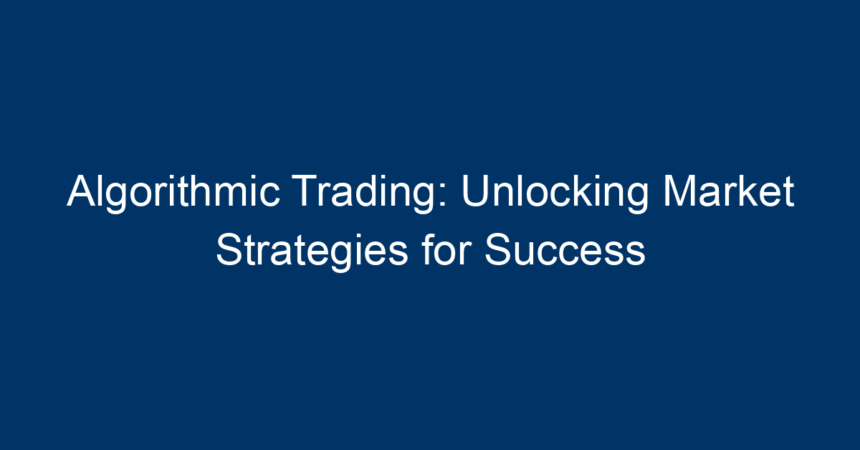In the dynamic world of financial markets, algorithmic trading has emerged as a paradigm shift, revolutionizing how traders and investors navigate the complexities of buying and selling securities. This innovative trading approach utilizes mathematical algorithms and computer programs to execute trades at lightning speed, maximizing efficiency and minimizing human error. In this article, we will explore the intricacies of algorithmic trading, unveil market strategies that lead to success, and provide actionable insights for aspiring traders.
Understanding Algorithmic Trading
What is Algorithmic Trading?
At its core, algorithmic trading is the process of using pre-defined sets of rules or algorithms to automate trading decisions. These algorithms can analyze vast amounts of market data in real-time, making split-second trades that capitalize on fleeting market opportunities. With sophisticated algorithms, traders can implement various strategies, from high-frequency trading to long-term investment approaches.
The Evolution of Algorithmic Trading
The roots of algorithmic trading can be traced back to the late 1970s, but it gained significant traction in the early 2000s, driven by advancements in technology and increased access to market data. Today, algorithmic trading accounts for a substantial share of overall trading volume in the global markets. As institutional investors and hedge funds leverage cutting-edge algorithms, individual traders are increasingly exploring how they can benefit from this approach.
The Benefits of Algorithmic Trading
Enhanced Speed and Efficiency
One of the primary advantages of algorithmic trading is its speed. Algorithms can execute trades in milliseconds, far faster than any human trader. This rapid execution helps capitalize on short-term market movements that might otherwise go unnoticed.
Reduced Costs
By automating trading strategies, traders can significantly cut down on transaction costs related to human intervention. Algorithms can be programmed to minimize slippage, optimize order execution, and reduce the overall market impact of trades, leading to better returns.
Data-Driven Decision-Making
Algorithmic trading relies on rigorous data analysis. Algorithms can process large data sets, identifying patterns, correlations, and trends that are often invisible to human analysts. This data-driven approach enhances decision-making by removing emotional bias and providing a clearer picture of market dynamics.
Strategies in Algorithmic Trading
1. Trend Following
Trend following is one of the most commonly used strategies in algorithmic trading. This approach involves identifying and capitalizing on upward or downward market trends. Algorithms can be programmed to recognize market trends through technical indicators such as moving averages or momentum indicators, executing buy or sell orders accordingly.
2. Arbitrage
Arbitrage opportunities arise when discrepancies in asset prices occur in different markets. Algorithmic trading can exploit these differences by buying low in one market and selling high in another. For instance, a stock might be undervalued on one exchange while overvalued on another. Algorithms can execute these trades instantaneously, capturing profits with minimal risk.
3. Market Making
Market making is a strategy where algorithms provide liquidity to the market by continually placing buy and sell orders. This strategy benefits from the bid-ask spread and ensures smoother trading. Algorithmic market makers often adjust prices dynamically based on market conditions, helping to stabilize prices in volatile times.
4. Statistical Arbitrage
Statistical arbitrage relies on statistical models to identify mispricings between correlated securities. This strategy involves simultaneously buying and selling related assets to profit from their expected convergence. Algorithms can continuously monitor these correlations and execute trades quickly to capitalize on fleeting opportunities.
5. Machine Learning Algorithms
With advancements in artificial intelligence, machine learning algorithms are gaining traction in algorithmic trading. These algorithms can learn from historical data and adapt to changing market conditions. By recognizing complex patterns and optimizing trading strategies accordingly, machine learning can enhance predictive accuracy.
Challenges and Risks in Algorithmic Trading
Market Volatility
While algorithmic trading offers significant advantages, it is not without its challenges. Market volatility can lead to unintended consequences if algorithms respond too aggressively. Ill-timed trades can result in substantial losses, highlighting the need for careful risk management.
Technical Failures
Dependence on technology also brings risks. System failures, network outages, or software glitches can lead to disastrous consequences. Ensuring robust infrastructure and fail-safes is crucial to mitigating these risks.
Regulatory Compliance
As algorithmic trading grows, regulatory scrutiny increases. Traders must comply with varying regulations across jurisdictions. Understanding compliance requirements is essential to avoid legal pitfalls and maintain market integrity.
Actionable Insights for Aspiring Algorithmic Traders
1. Education and Research
Before diving into the world of algorithmic trading, aspiring traders should invest time in education. Various online courses, webinars, and books are available that cover the fundamentals of algorithm development, programming languages such as Python, and market analysis techniques.
2. Start Small
For newcomers, starting with a small investment allows you to learn without risking significant capital. Use demo accounts or backtest algorithms with historical data to validate strategies before going live.
3. Develop a Trading Plan
A well-defined trading plan is a blueprint for success. Outline your goals, risk tolerance, and specific strategies. Consistently review and adjust your plan based on market changes and performance analysis.
4. Implement Risk Management Strategies
Risk management is paramount in algorithmic trading. Establish position sizing, stop-loss orders, and risk-reward ratios to mitigate potential losses. Utilizing these tools can help protect your capital during volatile market conditions.
5. Stay Updated on Market Trends
The financial markets are constantly evolving. Staying updated on market trends, news, and emerging technologies helps traders adapt and refine their algorithms. Attend conferences, join trading communities, and engage in discussions to build a well-rounded understanding.
Conclusion
Algorithmic trading has become an indispensable tool for modern traders seeking to navigate the complexities of financial markets efficiently. With its ability to enhance speed, reduce costs, and enable data-driven decision-making, it is no wonder that algorithmic trading continues to gain popularity. By understanding various strategies, recognizing challenges, and implementing necessary precautions, aspiring traders can unlock the vast potential of algorithmic trading for success. Embrace the future of trading, arm yourself with knowledge, and embark on the journey toward mastering algorithmic strategies. The opportunities are immense, and with the right tools and mindset, you can thrive in this fast-paced environment.




